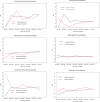Increased Burden of Second Bladder Cancer and Rectal Cancer in Prostate Cancer Treated With Radiotherapy: Results From Surveillance, Epidemiology, and End Results
- PMID: 37196346
- PMCID: PMC10196537
- DOI: 10.1177/10732748231177544
Increased Burden of Second Bladder Cancer and Rectal Cancer in Prostate Cancer Treated With Radiotherapy: Results From Surveillance, Epidemiology, and End Results
Abstract
Background: Previous studies have confirmed the higher risk of bladder cancer (BC) and rectal cancer (RC) development among prostate cancer (PCa) patients receiving radiotherapy. In this study, we intend to explore the long-term trend in second BC and RC incidence among PCa patients undergoing radiotherapy.
Method: We identified first primary PCa patients diagnosed between 1975 and 2014 from the Surveillance, Epidemiology, and End Results (SEER)-9 cancer registries. Standardized incidence ratios (SIRs) were calculated by calendar year of diagnosis among PCa patients receiving radiotherapy and not. P trends were evaluated using Poisson regression. 10-year cumulative incidence of BC and RC was calculated utilizing competing risk regression model.
Result: Of PCa patients treated with radiotherapy, SIRs of BC increased from .82 (95% CI: .35- 1.61) in 1980-1984 to 1.58 (95% CI: 1.48-1.68) in 2010-2014 (Ptrend=.003). SIRs of RC increased from 1.01 (95% CI: .27-2.58) in 1980-1984 to 1.54 (95% CI: 1.31-1.81) in 2010-2014 (Ptrend=.025). No statistically significant change in both BC and RC incidence was observed. The 10-year cumulative incidence of BC increased from 1975-1984 (.04%) to 2005-2014 (.15%) among PCa treated with radiotherapy. Simultaneously, the 10-year cumulative incidence of RC was demonstrated to range from 1975-1984 (.02%) to 2005-2014 (.11%).
Conclusion: we have observed an increasing trend in second BC and RC incidence in PCa patients receiving radiotherapy. There was no significant change in the incidence of second BC and RC in PCa without radiotherapy. These results reflect the increasing clinical burden of second malignant tumors in PCa patients undergoing radiotherapy.
Keywords: SEER; bladder cancer; prostate cancer; radiotherapy; rectal cancer; second malignant tumor.
Conflict of interest statement
The author(s) declared no potential conflicts of interest with respect to the research, authorship, and/or publication of this article.
Figures





Similar articles
-
External Beam Radiotherapy Increases the Risk of Bladder Cancer When Compared with Radical Prostatectomy in Patients Affected by Prostate Cancer: A Population-based Analysis.Eur Urol. 2019 Feb;75(2):319-328. doi: 10.1016/j.eururo.2018.09.034. Epub 2018 Oct 4. Eur Urol. 2019. PMID: 30293908
-
The impact of age at the time of radiotherapy for localized prostate cancer on the development of second primary malignancies.Urol Oncol. 2018 Nov;36(11):500.e11-500.e19. doi: 10.1016/j.urolonc.2018.06.007. Epub 2018 Sep 21. Urol Oncol. 2018. PMID: 30249519
-
Radiation therapy for prostate cancer increases subsequent risk of bladder and rectal cancer: a population based cohort study.J Urol. 2008 Nov;180(5):2005-9; discussion 2009-10. doi: 10.1016/j.juro.2008.07.038. Epub 2008 Sep 17. J Urol. 2008. PMID: 18801517
-
Association of radiotherapy with secondary pelvic cancers in male patients with rectal cancer.Int J Colorectal Dis. 2025 Mar 12;40(1):65. doi: 10.1007/s00384-025-04840-x. Int J Colorectal Dis. 2025. PMID: 40075051 Free PMC article.
-
Secondary Cancers After Radiation Therapy for Primary Prostate or Rectal Cancer.World J Surg. 2016 Apr;40(4):895-905. doi: 10.1007/s00268-015-3324-x. World J Surg. 2016. PMID: 26711638 Review.
Cited by
-
Risk factors for secondary bladder cancer following prostate cancer radiotherapy.Transl Androl Urol. 2024 Jul 31;13(7):1288-1296. doi: 10.21037/tau-23-667. Epub 2024 Jun 17. Transl Androl Urol. 2024. PMID: 39100827 Free PMC article. Review.
References
-
- Nieder AM, Porter MP, Soloway MS. Radiation therapy for prostate cancer increases subsequent risk of bladder and rectal cancer: a population based cohort study. J Urol. 2008;180(5):2005-2009. discussion 9-10. - PubMed
-
- Greenberger BA, Zaorsky NG, Den RB. Comparison of radical prostatectomy versus radiation and androgen deprivation therapy strategies as primary treatment for high-risk localized prostate cancer: a systematic review and meta-analysis. Eur Urol Focus. 2020;6(2):404-418. - PubMed
-
- Hall EJ. Intensity-modulated radiation therapy, protons, and the risk of second cancers. Int J Radiat Oncol Biol Phys. 2006;65(1):1-7. - PubMed
-
- Müller AC, Ganswindt U, Bamberg M, Belka C. Risk of second malignancies after prostate irradiation? Strahlenther Onkol. 2007;183(11):605-609. - PubMed
MeSH terms
LinkOut - more resources
Full Text Sources
Medical

